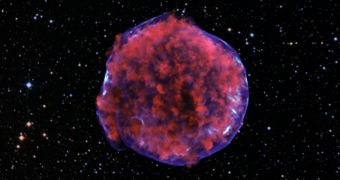A group of astronomers in the United States was recently able to determine how supernova remnants retain their glows long after the initial explosion has occurred. The team focused its attention on the famous cosmic object called Tycho's supernova remnants, which is located relatively close to Earth.
This structure has always puzzled astronomers because the material scattered around it continues to glow centuries after the massive star that spawned it exploded in a large supernova event. This is believed to have occurred in 1572, experts say, as a massive star at that location blew up.
The event threw all outer layers of the star's atmosphere in the space around it, and produced vast amounts of light, heat and radiation that were visible even from Earth. However, theory holds that the cloud of debris around the object should become less and less energetic as time passes.
This is not what observations of Tycho's SNR reveal, however. The material blasted around the core of the former star continues to glow at X-ray wavelengths nearly 450 years after the explosion occurred. The new study finally reveals how and why this process occurs.
Investigators from the Harvard-Smithsonian Center for Astrophysics (CfA) say that their latest observation of the remnant suggest the existence of a massive shock wave within the gas bubble, which is traveling in reverse at around 1,000 times the speed of sound (Mach 1,000).
“We wouldn't be able to study ancient supernova remnants without a reverse shock to light them up,” explains CfA investigator Hiroya Yamaguchi, the leader of the new study. Details of the work have already been accepted for publication in an upcoming issue of the Astrophysical Journal.
Yamaguchi and his team say that the outward-bound shock wave which accompanied the supernova event continues to travel away from the source of the explosion even today, at a speed of Mach 300. However, its interactions with the cosmic medium surrounding the original star create a backlash, too.
“It's like the wave of brake lights that marches up a line of traffic after a fender-bender on a busy highway. Thanks to the reverse shock, Tycho's supernova keeps on giving,” says Randall Smith, who was a coauthor of the new study. He holds an appointment as an astronomer at the CfA.
Researchers with the group say that they will now extend their studies on other supernova remnants similar to Tycho's SNR, in a bid to determine if backwards-traveling shock waves are common. The step beyond that would be to accurately characterize them, as well as their properties.

 14 DAY TRIAL //
14 DAY TRIAL //